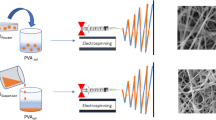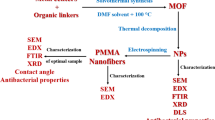Abstract
This investigation concerns the design of poly(3-hydroxybutyrate) (PHB)-based nanofibrous hybrid materials containing zinc oxide nanoparticles (nano-ZnO) by means of two electro-hydrodynamic techniques, i.e., electrospinning of polymer/nano-ZnO solutions and the combination of electrospinning of polymer solutions with electrospraying of nano-ZnO dispersions. The analysis of the physical properties associated with precursory solutions was performed in order to understand the final morphology of the corresponding nanofibers. The obtained PHB/nano-ZnO mats showed uniform fiber morphology with an average porosity ca. 85 % with enhanced thermal stability compared to that of pristine PHB. Differential scanning calorimetry was also used to determine the influence of ZnO nanoparticles in the phase transitions of as-spun PHB nanofibers. Furthermore, the antibacterial performance against E. coli and S. aureus proved to be dependent on the elaboration technique, thus permitting the design of novel bacteriostatic or bactericidal PHB/nano-ZnO nanofibrous composites.











Similar content being viewed by others
References
Ramier J, Bouderlique T, Stoilova O, Manolova N, Rashkov I, Langlois V, Renard E, Albanese P, Grande D (2014) Biocomposite scaffolds based on electrospun poly(3-hydroxybutyrate) nanofibers and electrosprayed hydroxyapatite nanoparticles for bone tissue engineering applications. Mater Sci Eng C 38:161–169. doi:10.1016/j.msec.2014.01.046
Ramier J, Grande D, Bouderlique T, Stoilova O, Manolova N, Rashkov I, Langlois V, Albanese P, Renard E (2014) From design of bio-based biocomposite electrospun scaffolds to osteogenic differentiation of human mesenchymal stromal cells. J Mater Sci Mater Med 25(6):1563–1575. doi:10.1007/s10856-014-5174-8
Sill TJ, von Recum HA (2008) Electrospinning: applications in drug delivery and tissue engineering. Biomaterials 29(13):1989–2006. doi:10.1016/j.biomaterials.2008.01.011
Villarreal-Gómez LJ, Cornejo-Bravo JM, Vera-Graziano R, Grande D (2016) Electrospinning as a powerful technique for biomedical applications: a critically selected survey. J Biomater Sci Polym Ed 27(2):157–176. doi:10.1080/09205063.2015.1116885
Speranza G, Gottardi G, Pederzolli C, Lunelli L, Canteri R, Pasquardini L, Carli E, Lui A, Maniglio D, Brugnara M, Anderle M (2004) Role of chemical interactions in bacterial adhesion to polymers surfaces. Biomaterials 25(11):2029–2037. doi:10.1016/j.biomaterials.2003.08.061
Pavithra D, Doble M (2008) Biofilm formation, bacterial adhesion and host response on polymeric implants: issues and prevention. Biomed Mater 3(3):034003. doi:10.1088/1748-6041/3/3/034003
Armentano I, Arciola CR, Fortunati E, Ferrari D, Mattioli S, Amoroso CF (2014) The interaction of bacteria with engineered nanostructured polymeric materials: a review. Sci World J 2014:410423. doi:10.1155/2014/410423
Abrigo M, McArthur SL, Kingshott P (2014) Electrospun nanofibers as dressings for chronic wound care: advances, challenges, and future prospects. Macromol Biosci 14(6):772–792. doi:10.1002/mabi.20130056
Augustine R, Malik HN, Singhal DK, Mukherjee A, Malakar D, Kalarikkal N, Thomas S (2014) Electrospun polycaprolactone/ZnO nanocomposite membranes as biomaterials with antibacterial and cell adhesion properties. J Polym Res 21(3):1–17. doi:10.1007/s10965-013-0347-6
Kumar PT, Lakshmanan VK, Anilkumar TV, Ramya C, Reshmi P, Unnikrishnan AG, Nair SV, Jayakumar R (2012) Flexible and microporous chitosan hydrogel/nano ZnO composite bandages for wound dressing: in vitro and in vivo evaluation. ACS Appl Mater Interfaces 4(5):2618–2629. doi:10.1021/am300292v
Mahapatra A, Garg N, Nayak BP, Mishra BG, Hota G (2012) Studies on the synthesis of electrospun PAN-Ag composite nanofibers for antibacterial application. J Appl Polym Sci 124(2):1178–1185. doi:10.1002/app.35076
Rodríguez-Tobías H, Morales G, Ledezma A, Romero J, Grande D (2014) Novel antibacterial electrospun mats based on poly(d, l-lactide) nanofibers and zinc oxide nanoparticles. J Mater Sci 49(24):8373–8385. doi:10.1007/s10853-014-8547-y
Francis L, Venugopal J, Prabhakaran MP, Thavasi V, Marsano E, Ramakrishna S (2010) Simultaneous electrospin-electrosprayed biocomposite nanofibrous scaffolds for bone tissue regeneration. Acta Biomater 6(10):4100–4109. doi:10.1016/j.actbio.2010.05.001
Korina E, Stoilova O, Manolova N, Rashkov I (2014) Poly(3-hydroxybutyrate)-based hybrid materials with photocatalytic and magnetic properties prepared by electrospinning and electrospraying. J Mater Sci 49(5):2144–2153. doi:10.1007/s10853-013-7907-3
Mangeon C, Mahouche-Chergui S, Versace DL, Guerrouache M, Carbonnier B, Langlois V, Renard E (2015) Poly(3-hydroxyalkanoate)-grafted carbon nanotube nanofillers as reinforcing agent for PHAs-based electrospun mats. React Funct Polym 89:18–23. doi:10.1016/j.reactfunctpolym.2015.03.001
Talebian N, Amininezhad SM, Doubi M (2013) Controllable synthesis of ZnO nanoparticles and their morphology-dependent antibacterial and optical properties. J Photochem Photobiol C 120:66–73. doi:10.1016/j.jphotobiol.2013.01.004
Wahab R, Mishra A, Yun SI, Kim YS, Shin HS (2010) Antibacterial activity of ZnO nanoparticles prepared via non-hydrolytic solution route. Appl Microbiol Biotechnol 87(5):1917–1925. doi:10.1007/s00253-010-2692-2
Tayel AA, El-Tras WF, Moussa S, El-Baz AF, Mahrous H, Salem MF, Brimer L (2011) Antibacterial action of zinc oxide nanoparticles against foodborne pathogens. J Food Saf 31(2):211–218. doi:10.1111/j.1745-4565.2010.00287.x
Premanathan M, Karthikeyan K, Jeyasubramanian K, Manivannan G (2011) Selective toxicity of ZnO nanoparticles toward Gram-positive bacteria and cancer cells by apoptosis through lipid peroxidation. Nanomedicine 7(2):184–192. doi:10.1016/j.nano.2010.10.001
Barreto GP, Morales G, Quintanilla MLL (2013) Microwave assisted synthesis of ZnO nanoparticles: effect of precursor reagents, temperature, irradiation time and additives on nano-ZnO morphology development. J Mater ID 478681
Augustine R, Dominic EA, Reju I, Kaimal B, Kalarikkal N, Thomas S (2014) Electrospun polycaprolactone membranes incorporated with ZnO nanoparticles as skin substitutes with enhanced fibroblast proliferation and wound healing. RSC Adv 4(47):24777. doi:10.1039/c4ra02450h
Shalumon KT, Anulekha KH, Nair SV, Chennazhi KP, Jayakumar R (2011) Sodium alginate/poly(vinyl alcohol)/nano ZnO composite nanofibers for antibacterial wound dressings. Int J Biol Macromol 49(3):247–254. doi:10.1016/j.ijbiomac.2011.04.005
Wang Y, Zhang Q, C-l Zhang, Li P (2012) Characterisation and cooperative antimicrobial properties of chitosan/nano-ZnO composite nanofibrous membranes. Food Chem 132(1):419–427. doi:10.1016/j.foodchem.2011.11.015
Burks T, Akthar F, Saleemi M, Avila M, Kiros Y (2015) ZnO-PLLA nanofiber nanocomposite for continuous flow mode purification of water from Cr(VI). J Environ Public Health 2015:1–7. doi:10.1155/2015/687094
Kayaci F, Ozgit-Akgun C, Donmez I, Biyikli N, Uyar T (2012) Polymer-inorganic core-shell nanofibers by electrospinning and atomic layer deposition: flexible nylon-ZnO core-shell nanofiber mats and their photocatalytic activity. ACS Appl Mater Interfaces 4(11):6185–6194. doi:10.1021/am3017976
Virovska D, Paneva D, Manolova N, Rashkov I, Karashanova D (2014) Electrospinning/electrospraying vs. electrospinning: a comparative study on the design of poly(l-lactide)/zinc oxide non-woven textile. Appl Surf Sci 311:842–850. doi:10.1016/j.apsusc.2014.05.192
Jendrossek D, Handrick R (2002) Microbial degradation of polyhydroxyalkanoates. Annu Rev Microbiol 56:403–432. doi:10.1146/annurev.micro.56.012302.160838
Suwantong O, Waleetorncheepsawat S, Sanchavanakit N, Pavasant P, Cheepsunthorn P, Bunaprasert T, Supaphol P (2007) In vitro biocompatibility of electrospun poly(3-hydroxybutyrate) and poly(3-hydroxybutyrate-co-3-hydroxyvalerate) fiber mats. Int J Biol Macromol 40(3):217–223. doi:10.1016/j.ijbiomac.2006.07.006
Diez-Pascual AM, Diez-Vicente AL (2014) Poly(3-hydroxybutyrate)/ZnO bionanocomposites with improved mechanical, barrier and antibacterial properties. Int J Mol Sci 15(6):10950–10973. doi:10.3390/ijms150610950
P-o Rujitanaroj, Pimpha N, Supaphol P (2008) Wound-dressing materials with antibacterial activity from electrospun gelatin fiber mats containing silver nanoparticles. Polymer 49(21):4723–4732. doi:10.1016/j.polymer.2008.08.021
Zahedi P, Rezaeian I, Ranaei-Siadat S-O, Jafari S-H, Supaphol P (2009) A review on wound dressings with an emphasis on electrospun nanofibrous polymeric bandages. Polym Adv Technol 21(2):77–95. doi:10.1002/pat.1625
Sen CK (2009) Wound healing essentials: let there be oxygen. Wound Repair Regen 17(1):1–18. doi:10.1111/j.1524-475X.2008.00436.x
Rainer A, Centola M, Spadaccio C, Gherardi G, Genovese JA, Licoccia S, Trombetta M (2010) Comparative study of different techniques for the sterilization of poly-L-lactide electrospun microfibers: effectiveness vs. material degradation. Int J Artif Organs 33(2):76–85
Janorkar AV, Metters AT, Hirt DE (2007) Degradation of poly(L-lactide) films under ultraviolet-induced photografting and sterilization conditions. J Appl Polym Sci 106(2):1042–1047. doi:10.1002/app.24692
Yu W, Lan C-H, Wang S-J, Fang P-F, Sun Y-M (2010) Influence of zinc oxide nanoparticles on the crystallization behavior of electrospun poly(3-hydroxybutyrate-co-3-hydroxyvalerate) nanofibers. Polymer 51(11):2403–2409. doi:10.1016/j.polymer.2010.03.024
Zhou S, Zheng X, Yu X, Wang J, Weng J, Li X, Feng B, Yin M (2007) Hydrogen bonding interaction of poly(D, L-lactide)/hydroxyapatite nanocomposites. Chem Mater 19(2):247–253
Brayner R, Ferrari-Iliou R, Brivois N, Djediat S, Benedetti MF, Fiévet F (2006) Toxicological impact studies based on E. coli bacteria in ultrafine ZnO nanoparticles colloidal medium. Nano Lett 6(4):866–870. doi:10.1021/nl052326h
Amna T, Hassan MS, Barakat NA, Pandeya DR, Hong ST, Khil MS, Kim HY (2012) Antibacterial activity and interaction mechanism of electrospun zinc-doped titania nanofibers. Appl Microbiol Biotechnol 93(2):743–751. doi:10.1007/s00253-011-3459-0
Sirelkhatim A, Mahmud S, Seeni A, Kaus NHM, Ann LC, Bakhori SKM, Hasan H, Mohamad D (2015) Review on zinc oxide nanoparticles: antibacterial activity and toxicity mechanism. Nano-Micro Lett 7(3):219–242. doi:10.1007/s40820-015-0040-x
Acknowledgements
Financial support through French-Mexican PCP Program is gratefully acknowledged. The authors thank CONACyT (Mexico) for providing H. Rodríguez-Tobías with a Ph.D. Grant. They also thank J. Cepeda and M. Lozano (CIQA, Mexico) and R. Pires (CNRS, France) for their technical assistance in issues related to electron microscopy characterization, as well as J. Quiroz, C. N. Alvarado, and D. Rodríguez (CIQA, Mexico) for their technical support.
Author information
Authors and Affiliations
Corresponding authors
Electronic supplementary material
Below is the link to the electronic supplementary material.
Rights and permissions
About this article
Cite this article
Rodríguez-Tobías, H., Morales, G., Ledezma, A. et al. Electrospinning and electrospraying techniques for designing novel antibacterial poly(3-hydroxybutyrate)/zinc oxide nanofibrous composites. J Mater Sci 51, 8593–8609 (2016). https://doi.org/10.1007/s10853-016-0119-x
Received:
Accepted:
Published:
Issue Date:
DOI: https://doi.org/10.1007/s10853-016-0119-x




